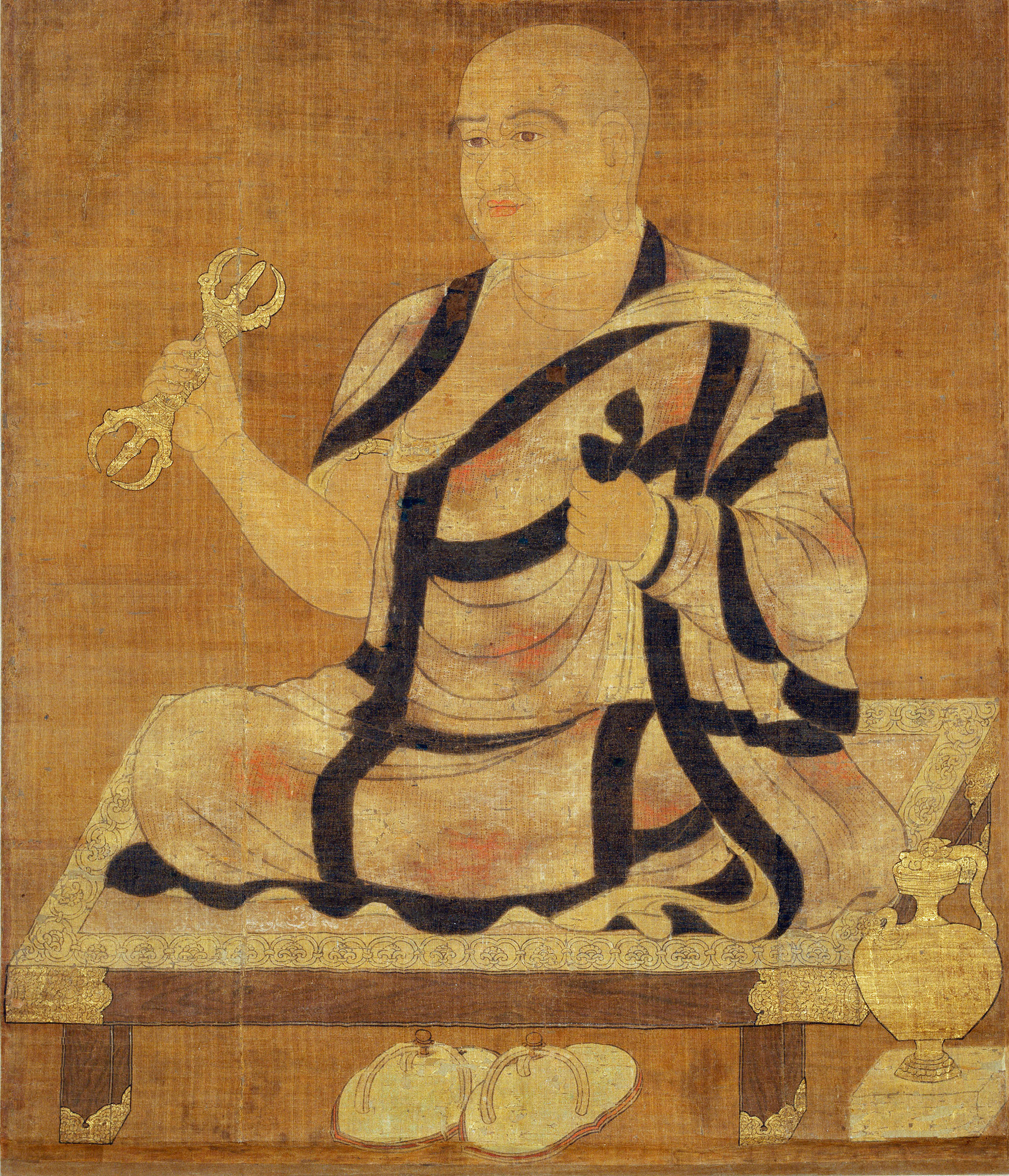|
Trairūpya
''Trairūpya (''Sanskrit; English: "the triple-character of inferential sign") is a conceptual tool of Buddhist logic. The Trairūpya, ‘three conditions’, is oft accredited to Dignaga (c. 480-540 CE) though is now understood to have originated with his teacher Vasubandhu (fl. 4th century) in the ''Vāda-vidhi'', post-reconstruction of this work by Frauwallner (1957). Trairūpya is a logical argument that contains three constituents which a logical ‘sign’ or ‘mark’ (linga) must fulfill to be 'valid source of knowledge' (pramana): #It should be present in the case or object under consideration, the ‘subject-locus' (pakṣa) #It should be present in a ‘similar case’ or a homologue (sapakṣa) #It should not be present in any ‘dissimilar case’ or heterologue (vipakṣa) When a ‘sign’ or ‘mark’ (linga) is identified, there are three possibilities: the sign may be present in all, some, or none of the sapakṣas. Likewise, the sign may be present in all ... [...More Info...] [...Related Items...] OR: [Wikipedia] [Google] [Baidu] |
Buddhist Logic
Buddhist logico-epistemology is a term used in Western scholarship for '' pramāṇa-vāda'' (doctrine of proof) and ''Hetu-vidya'' (science of causes). Pramāṇa-vāda is an epistemological study of the nature of knowledge; Hetu-vidya is a system of logic. These models developed in India during the 5th through 7th centuries. The early Buddhist texts show that the historical Buddha was familiar with certain rules of reasoning used for debating purposes and made use of these against his opponents. He also seems to have held certain ideas about epistemology and reasoning, though he did not put forth a logico-epistemological system. The structure of debating rules and processes can be seen in the early Theravada text the Kathāvatthu. The first Buddhist thinker to discuss logical and epistemic issues systematically was Vasubandhu in his ''Vāda-vidhi'' ("A Method for Argumentation"), who was influenced by the Hindu work on reasoning, the '' Nyāya-sūtra''.Anacker, Stefan (2005, r ... [...More Info...] [...Related Items...] OR: [Wikipedia] [Google] [Baidu] |
Hetucakra
''Hetucakra'' or ''Wheel of Reasons'' is a Sanskrit text on logic written by Dignaga (c 480–540 CE). It concerns the application of his 'three modes’ ( trairūpya), conditions or aspects of the middle term called ''hetu'' ("reason" for a conclusion) or ''linga'' ("mark", "sign" of a sound argument) in a valid inference within the Indian logico-epistemic tradition, sometimes referred to as Buddhist logic. Anacker's assessment Anacker (2005: p. 34), in introducing his English rendering of the "Method for Argumentation (Vāda-vidhi)" of Vasubandhu (fl. 4th century)—a text composed in Sanskrit which is now only extant in a reconstructed composite extracted from Tibetan works, collated by Frauwallner (1957)—holds that: Vasubandhu's criteria for a valid inference-schema are concise and precise, and there is nothing essential omitted. Dignāga's 'wheel of justifications' (''hetu-cakra''), sometimes held to be the first complete Indian formulation of what constitutes the v ... [...More Info...] [...Related Items...] OR: [Wikipedia] [Google] [Baidu] |
Vasubandhu
Vasubandhu (; Tibetan: དབྱིག་གཉེན་ ; floruit, fl. 4th to 5th century CE) was an influential bhikkhu, Buddhist monk and scholar from ''Puruṣapura'' in ancient India, modern day Peshawar, Pakistan. He was a philosopher who wrote commentary on the Abhidharma, from the perspectives of the Sarvastivada and Sautrāntika schools. After his conversion to Mahayana, Mahayana Buddhism, along with his half-brother, Asanga, he was also one of the main founders of the Yogacara school. Vasubandhu's ''Abhidharmakośakārikā'' ("Commentary on the Treasury of the Abhidharma") is widely used in Tibetan and East Asian Buddhism, as the major source for non-Mahayana Abhidharma philosophy. His philosophical verse works set forth the standard for the Indian Yogacara metaphysics of "appearance only" (''vijñapti-mātra''), which has been described as a form of "epistemological idealism", Phenomenology (philosophy), phenomenology and close to Immanuel Kant's transcendental ideali ... [...More Info...] [...Related Items...] OR: [Wikipedia] [Google] [Baidu] |
Erich Frauwallner
Erich Frauwallner (December 28, 1898 – July 5, 1974) was an Austrian professor, a pioneer in the field of Buddhist studies.Walter Slaje: Rezensionen, Stuchlik, Jakob: Der arische Ansatz. Erich Frauwallner und der Nationalsozialismus, Asiatische Studien – Études Asiatiques 64, p. 447–463 (2010PDF/ref>Stuchlik, Replik auf Walter Slajes Rezension meines Buches Der arische Ansatz. Erich Frauwallner und der Nationalsozialismus, Asiatische Studien - Études Asiatiques Bd. 65.1, 287-308 (2011PDF/ref> Career and life Frauwallner studied classical philology and Sanskrit philology in Vienna. He taught Indology from 1928-29 at the University of Vienna. His primary interest was Buddhist logic and epistemology, and later Indian Brahmanic philosophy, with close attention to primary source texts. In 1938 Frauwallner joined the Department of Indian and Iranian philosophy at the Oriental Institute after its Jewish director, Bernhard Geiger, was forced out; Frauwallner became director in ... [...More Info...] [...Related Items...] OR: [Wikipedia] [Google] [Baidu] |
Pramana
''Pramana'' (Sanskrit: प्रमाण, ) literally means " proof" and "means of knowledge".pramANa Sanskrit-English Dictionary, Koeln University, GermanyJames Lochtefeld, "Pramana" in The Illustrated Encyclopedia of Hinduism, Vol. 2: N-Z, Rosen Publishing. , pages 520-521 In Indian philosophies, pramana are the means which can lead to knowledge, and serve as one of the core concepts in Indian . It has been one of the key, much debated fields of study in , |
History Of Logic
The history of logic deals with the study of the development of the science of valid inference (logic). Formal logics developed in ancient times in Indian logic, India, Logic in China, China, and Greek philosophy, Greece. Greek methods, particularly Aristotelian logic (or term logic) as found in the ''Organon'', found wide application and acceptance in Western science and mathematics for millennia.Boehner p. xiv The Stoicism, Stoics, especially Chrysippus, began the development of predicate logic. Christian philosophy, Christian and Logic in Islamic philosophy, Islamic philosophers such as Boethius (died 524), Ibn Sina (Avicenna, died 1037) and William of Ockham (died 1347) further developed Plato's logic in the Medieval philosophy#High Middle Ages, Middle Ages, reaching a high point in the mid-fourteenth century, with Jean Buridan. The period between the fourteenth century and the beginning of the nineteenth century saw largely decline and neglect, and at least one historian of l ... [...More Info...] [...Related Items...] OR: [Wikipedia] [Google] [Baidu] |

